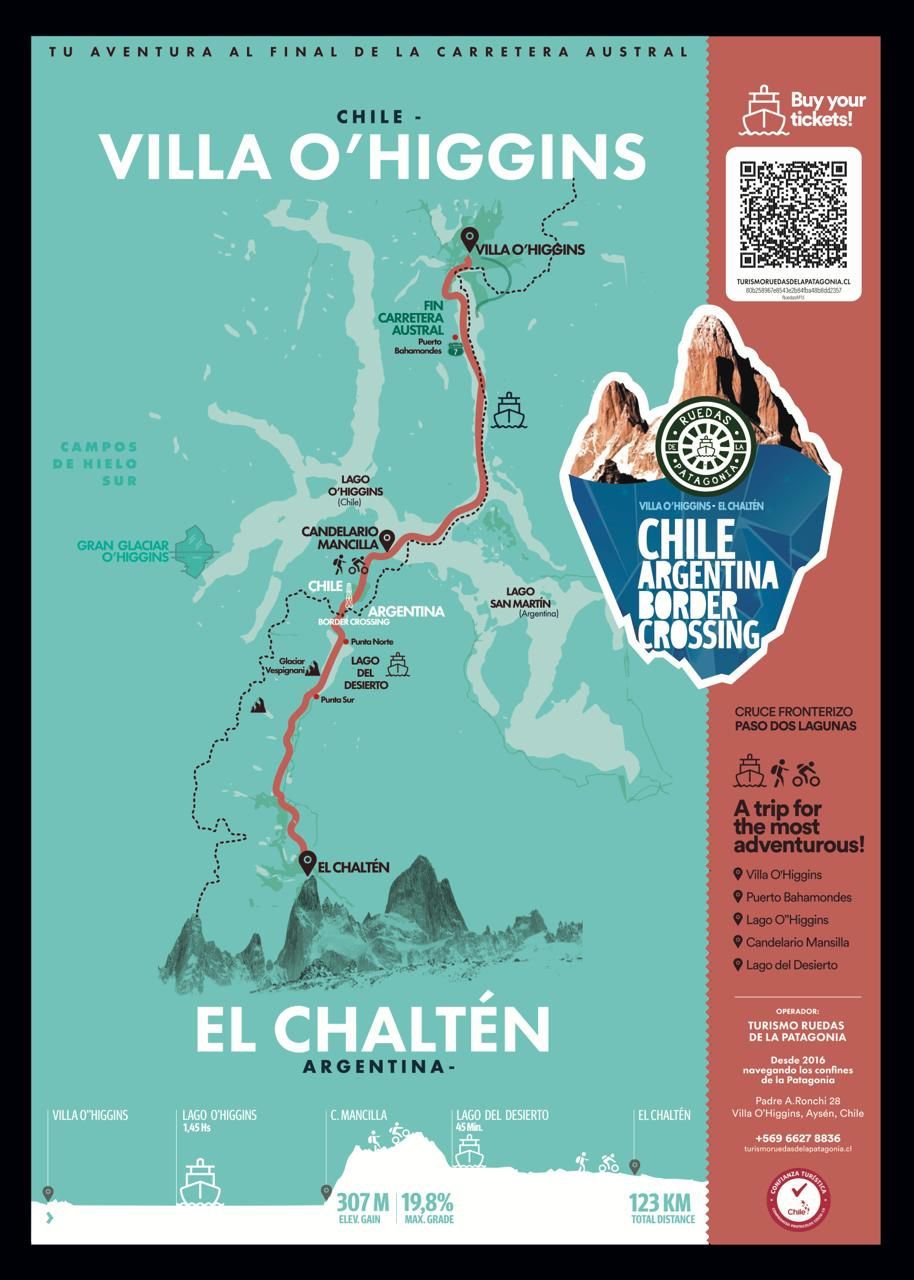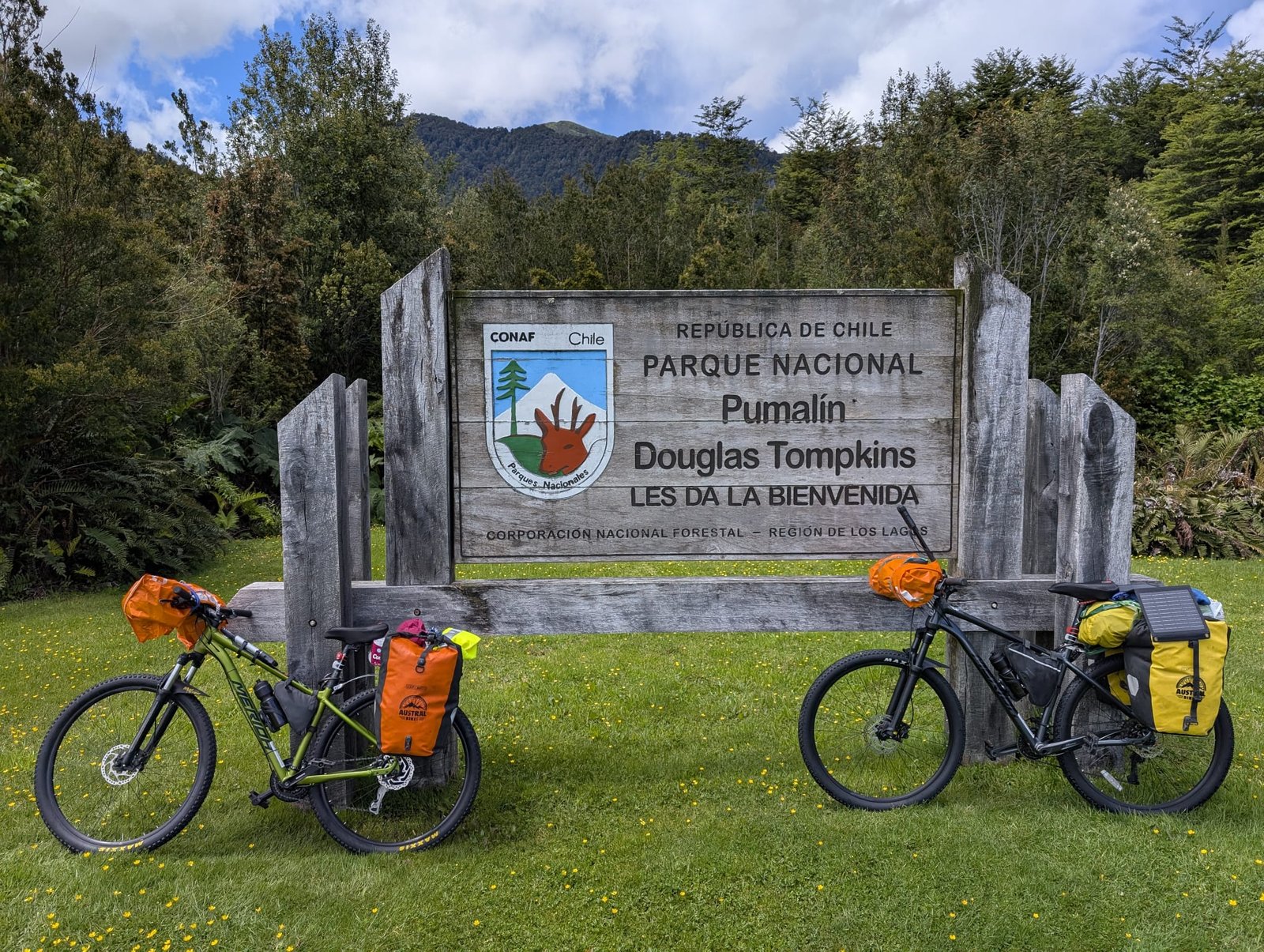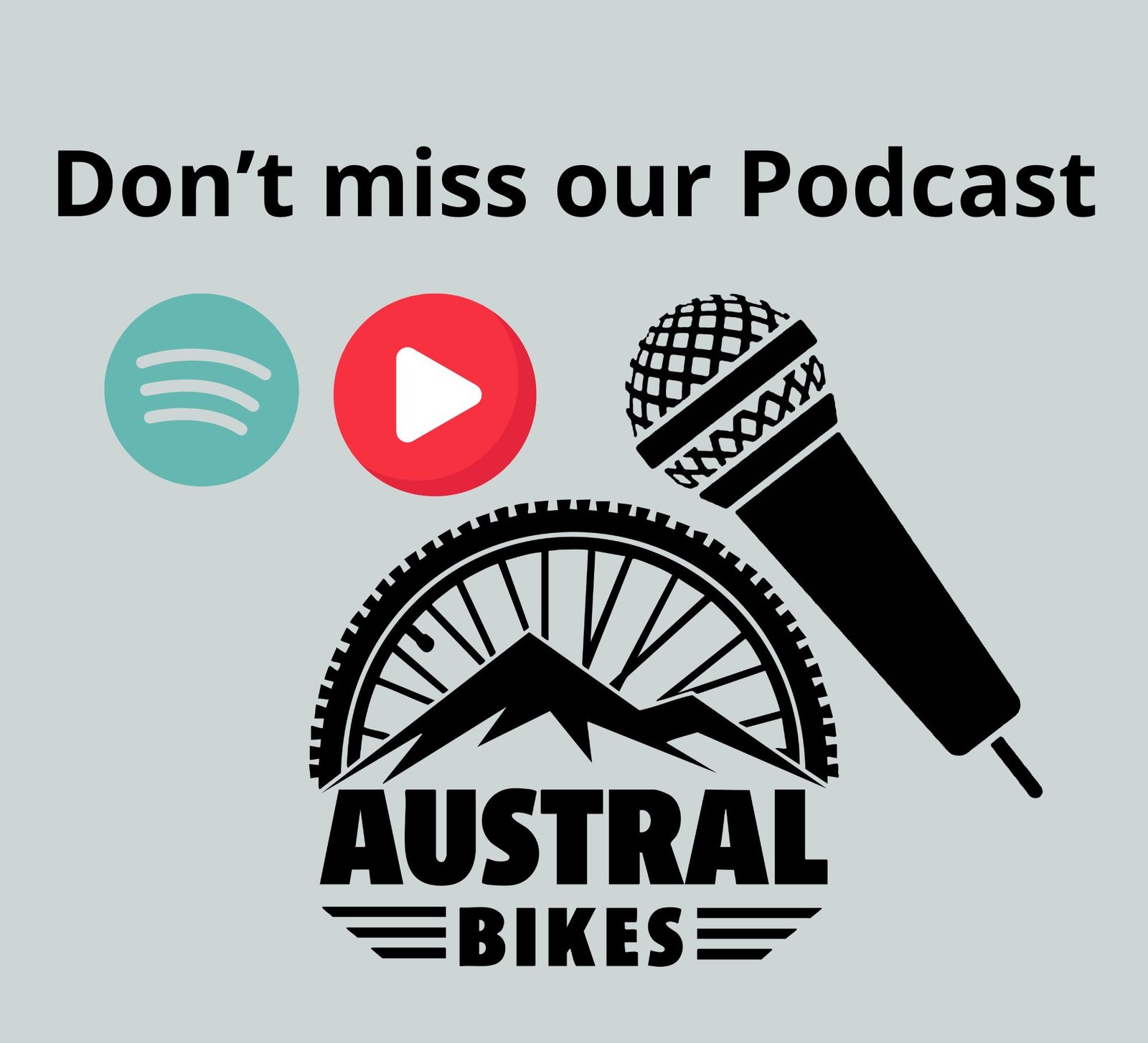Carretera Austral
Puerto Varas to Villa
O´Higgins
SUGGESTED ITINERARY – From North to South
Puerto Varas to Villa O Higgins.
You will need time to enjoy trekking, kayaking, fishing and other outdoor activities.
We have designed this itinerary with some extra days.
IF YOU WANT, YOU CAN SPEED UP AND CYCLE FASTER, OR REDUCE YOUR SPEED IF YOUR LEGS ARE TOO TIRED, AND REST A COUPLE OF DAYS.
WE SUGGEST TO SPEND BETWEEN 25-30 DAYS ON CARRETERA AUSTRAL.
DAY 0: Arrival at Tepual Airport
The nearest Airport is El Tepual (PMC) in Puerto Montt. All domestic flights are operated by three local airline companies: Latam, Sky Airlines and JetSmart. Its very easy to get transport to Puerto Varas. Two good transfer companies at Tepual´s Airport are Turis Tour or Survip.
They offer regular and private shuttles to Puerto Varas at $ 30.000 CLP.
DAY 1: Puerto Varas to Ensenada - 45km
Today’s ride is about 43 kilometers, mostly flat and scenic. You’ll follow the Ruta 225 along the southern edge of Lake Llanquihue. It’s a paved road, with some traffic near town, but it gets quieter as you ride east.
On a clear day, the Osorno Volcano towers to your left, and you might catch views of Calbuco and Puntiagudo too. Stop whenever you like—this part of the trip is made for slow pedaling and photo breaks.
After arriving to Ensenada, you can leave your bags at the hostel and visit Saltos de Petrohué ** remember to secure the bike with the lock that we have provided to you, and you can also visit Lake Todos los Santos (if you are not too tired).
DAY 2: Ensenada to Cochamó - 48km
You’re leaving behind the last signs of lakeside tourism today and heading deeper into rural Patagonia. The ride from Ensenada to Cochamó is about 47 kilometers, following the V-69—a peaceful, paved route with stunning views and very little traffic.
The first few kilometers out of Ensenada are easy. You’ll ride past small farms, lush pastures, and dense green forests. With any luck, you’ll see Osorno Volcano in your mirror and Calbuco Volcano ahead as you trace the edge of the Reloncaví Estuary.
Cochamó has been called the Yosemite of Chile, the Valley is beyond comparison, the granite cliffs rise one thousand meters from the valley floor.
DAY 3: Cochamó to Contao - 77km
BE PREPARED – This section is difficult! You’ll follow Route V-69 as it twists along the Reloncaví EstuaryThe ride begins with rolling hills through dense green forest. Ferns, moss, and misty mountain views will keep you company.
There’s not much in the way of shops or services along the route, so be sure to pack snacks and water.
Midway through the ride, you’ll pass through Puelche, a tiny hamlet with a small ferry dock—don’t confuse it with Caleta Puelche, which is across the fjord. You’re staying on this side of the water.Keep pedaling and you’ll eventually descend toward Contao, a quiet fishing village tucked beside the fjord.
DAY 4: Contao to Hornopirén - 45km
As you continue South, the density of the forests will increase considerably and inversely the towns and houses will decrease.. After Contao, the supplies offered will be mostly bread.
Hualaihué, Caleta Manzano and Pichicolo are good options to have lunch or find some more supplies, you can also chose to buy supplies in Hornopirén where there are supermarkets, stores and restaurants. At Hornopirén you will find the office of Somarco. you can buy tickets for the Bimodal Ferry that will allow you to continue to Caleta Gonzalo in Pumalín Park.

DAY 5: Hornopirén to Caleta Gonzalo- BIMODAL FERRY
Discover majestic landscapes, and marine species, thanks to this route crossing the interior of the fjords, give some rest to your legs as today you willl only cycle 10km.
The ferry departs in Hornopirén, you will first sail for approximately 3 hours and 30 minutes to Leptepu. From there, the route continues by land (on bus for 15 minutes, or cycling the 10km to Fiordo Largo), then you will sail again the last stretch of the sea to Caleta Gonzalo, which lasts 45 minutes.
DAY 6: Caleta Gonzalo to Chaitén - 56km
You’ll be covering around 60 kilometers today, and while it’s a bit longer than previous days, the terrain is mostly gentle, with some rolling hills and occasional steep sections. It’s all gravel—ripio—but well maintained and surrounded by raw, untouched nature.
As you leave Caleta Gonzalo, you’ll be cycling through the heart of Pumalín Douglas Tompkins National Park. This part of the route feels like a dream—dense Valdivian rainforest, waterfalls cascading down mossy cliffs, and towering mountains blanketed in green.
DAY 7: Chaitén to Villa Santa Lucía - 70km
From the volcanic town of Chaitén to the small settlement of Villa Santa Lucía—about 70 kilometers of winding road through valleys shaped by glaciers and eruptions.
This section is still all gravel, but it’s in excellent condition. You’ll start by leaving Chaitén behind, following the Carretera Austral southward as it hugs the Yelcho River. The views are spectacular on your left, the river rushes through a wide, forested valley; on your right, the flanks of volcanoes disappear into mist.
After about 30 kilometers, you’ll come to one of the most beautiful spots on the entire route: the Yelcho Lake.
DAY 8: Villa Santa Lucía to La Junta - 69km
From the quiet village of Villa Santa Lucía to the lush, green valley of La Junta — a scenic stretch of about 69 kilometers, with gentle hills, wild rivers, and some of the freshest air you’ll ever breathe.
The road is mostly paved, though you’ll still encounter occasional sections of gravel. Expect rolling terrain with a few moderate climbs, nothing too intense, but enough to keep your legs working.
As you leave Villa Santa Lucía, take a moment to reflect: this small settlement was heavily affected by a devastating landslide in 2017. The rebuilt village stands as a symbol of resilience and recovery.
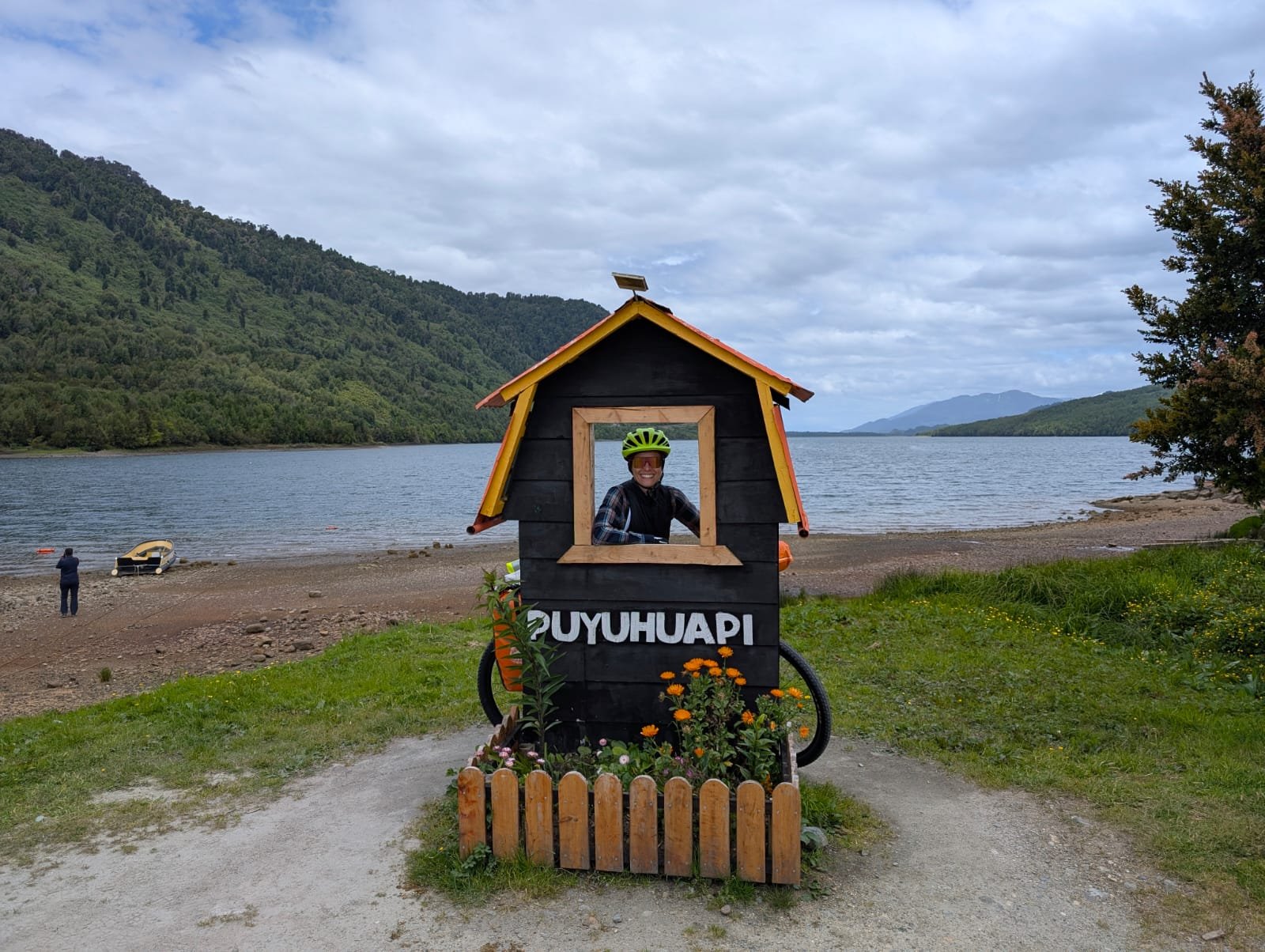
DAY 9: La Junta to Puyuhuapi - 44km
This stretch is a favorite among cyclists, not just for its scenery, but for the sense of calm and connection to nature that it offers.
The road is paved and gently rolling, winding through lush temperate rainforest, with rivers, waterfalls, and towering ferns lining the way. It’s an easygoing ride, perfect for recovering after longer days in the saddle.
About halfway through the ride, you’ll cross the Rosselot River. It’s a great spot to stop and take in the view or even dip your feet in the water if the weather allows.

DAY 10: Puyuhuapi to Queulat National Park - 22km
Today we trade kilometers for wonder, as we ride just 22 kilometers south from Puyuhuapi to the entrance of Parque Nacional Queulat. The short distance gives you time to hike to one of Patagonia’s most breathtaking views: the Ventisquero Colgante, or Hanging Glacier.
The road starts easy as you roll out of Puyuhuapi, following the edge of the fjord with misty mountain backdrops. After about 14 kilometers, the terrain begins to climb. The ascent is steady but manageable — about 8 kilometers of uphill through thick temperate rainforest. Take it slow and enjoy the surroundings.
DAY 11: Queulat National Park to Villa Mañihuales - 78km
Mixed terrain, including gravel, steep descents, and sweeping river views — a day that will test your endurance and reward you with unforgettable landscapes.
As you leave Queulat, you’ll begin with a descent through dense forest. The road here is mostly gravel, often slippery when wet, so take it slow. The further you ride, the more the scenery opens up — dense temperate forest gives way to wide glacial valleys, braided rivers, and snow-dusted peaks.
There are few services along the way, so pack snacks, plenty of water, and be prepared for changes in weather. One of the most striking parts of this ride is the descent into the Río Cisnes valley, where you’ll follow the river for several kilometers. This is prime territory for spotting condors overhead and gauchos moving cattle on horseback.
DAY 12: Villa Mañihuales to Coyhaique – 85 kM
Today you ride into one of the most important stops on your journey: the regional capital of Coyhaique. It’s a long ride — about 85 kilometers — but the reward is big: a rest day in a lively Patagonian town, and for those riding with Austral Bikes, a complete preventive maintenance check to keep your bike running smoothly for the road ahead.
You’ll start the day rolling out of Villa Mañihuales, a quiet village surrounded by rivers and mountains. The first part of the route is relatively flat, with occasional short climbs. The road is paved, and traffic begins to increase as you get closer to Coyhaique, so stay alert.
After about 40 kilometers, the landscape begins to change. Wide valleys narrow, and the road starts climbing toward Cerro Rosado. This section includes one of the steepest uphill stretches so far — about 5 kilometers of steady ascent — followed by a thrilling descent into the Simpson River Valley.
The stretch from Coyhaique to Cerro Castillo is a classic ride on the Carretera Austral — 97 kilometers of winding roads, open valleys, and unforgettable mountain views.
If you’re well-prepared and fit, it can definitely be done in a single day.
Our advise is to take it slow and soak it all in, we recommend splitting it into two:
– Day one from Coyhaique to the small village of El Blanco
– Day two from El Blanco to Cerro Castillo, where you’ll conquer the legendary Cuesta del Diablo — a challenging climb with epic rewards at the top.
DAY 13: Coyhaique to El Blanco– 35 km
Leaving Coyhaique, you’ll quickly find yourself in the countryside again. The first 30 kilometers are fairly gentle, passing through open farmland, sheep pastures, and small estancias. The road is paved, and traffic gradually fades as you move further from the city.
YOU MAY THINK THIS SECTION IS TOO SHORT..But make no mistake — You will soon reach one of the longest climbs of the Carretera Austral. After a brief descent into the Río Simpson valley, you begin the ascent to the portezuelo Ibáñez. It’s about 18 kilometers of climbing, not too steep, but relentless. The scenery helps: glacier-fed rivers, lenga forests, and dramatic ridgelines line the way up.
At the top, take a break and enjoy the view — you’ve earned it. The descent from the pass is pure joy: sweeping curves, fresh mountain air, and snowcapped peaks all around. This is one of the best downhill sections of the entire route.

DAY 14: El Blanco to Cerro Castillo – 42 km
The day begins quietly as you leave El Blanco, but don’t be fooled — within a few kilometers, the climb begins. The Cuesta del Diablo is a 764-meter ascent over roughly 10 kilometers. The gradient varies, but it’s steady, exposed, and relentless.
There’s little shade, and if the sun is out, it can be intense. But as you gain altitude, the landscape opens up into sweeping mountain views and wide glacial valleys. Take your time, breathe deeply, and stop when you need to. It’s not a race — it’s a pilgrimage into the Andes.
At the top, take a break. The sense of accomplishment is real, and the reward is even greater: a long, winding descent through one of the most spectacular stretches of the Carretera Austral.
The final kilometers into Villa Cerro Castillo are pure magic. The road curves through meadows, crosses turquoise streams, and eventually reveals the jagged spires of the Torres de Cerro Castillo — towering black rock peaks that dominate the skyline.
DAY 15: Cerro Castillo to Puerto Río Tranquilo – 120 km - 1 or 2 days
Today you’ll descend from the mountains to one of the most beautiful bodies of water in all of South America: Lago General Carrera. It’s a 73-kilometer ride from Cerro Castillo to Puerto Río Tranquilo, a long but stunning journey through open valleys, wild rivers, and glacier-fed lakes.
Leaving Cerro Castillo, the day starts gently, rolling through grasslands and lenga forests, with the jagged towers of the mountain behind you. You’ll soon begin descending — and the views are breathtaking. Glaciers hang from peaks, waterfalls cut through cliffs, and in the distance, the turquoise shimmer of the lake appears.
Expect occasional rough patches and some steep switchbacks as you lose altitude. Watch your speed and enjoy the scenery — it’s worth stopping often.
Midway through the ride, you’ll pass the Murta River, one of many glacial streams feeding into Lago General Carrera. This area is rich with birdlife, and if the wind is calm, you’ll hear nothing but water and the sound of your tires.

DAY 16: Rest Day in Puerto Río Tranquilo – Marble Caves & Glacier Exploradores
You’ve arrived in Puerto Río Tranquilo, one of the most scenic and unforgettable stops along the entire route. No kilometers to cover on your bike today, but there’s plenty to discover.
First, the star of the show: the Catedral de Mármol, or Marble Caves.
These surreal rock formations rise directly from the turquoise waters of Lago General Carrera. Sculpted over thousands of years by waves and wind, the caves glow in swirling patterns of blue and white — and the best way to see them is by kayak or small boat.
Sunlight reflects off the water and dances along the stone, creating a dreamlike, otherworldly experience. Early morning is best, when the light is soft and the water calm. It’s not just beautiful — it’s peaceful, meditative, and completely unique.
If you’re looking for a different kind of adventure, head inland toward the Glaciar Exploradores.

DAY 17: Puerto Río Tranquilo to Puerto Bertrand – 57 km
A journey of about 57 kilometers, filled with dramatic lake views, hidden valleys, and the powerful presence of the Río Baker.
Leaving Puerto Río Tranquilo, the road quickly returns to gravel. You’ll ride along the southern edge of Lago General Carrera, the largest lake entirely in Chile, with its signature deep turquoise color on full display. The road rolls gently at first, with some short climbs and descents hugging the cliffs and hillsides.
About halfway through the ride, you’ll pass close to Bahía Murta, a tiny settlement nestled on the lake’s edge. It’s a good place to rest, grab a snack, or chat with locals if you’re in no rush. From here, the landscape becomes even wilder.
You’ll continue along the lake before the road turns slightly inland, following a chain of valleys and glacial streams. Eventually, you’ll arrive at the northern tip of Lago Bertrand, where the lake empties into the Río Baker — Chile’s most powerful river.
Bike and Outdoor Rental
Need a quote?
Send us an email to: info@australbikes.cl
NEED LODGING?
Please, write us a message: info@australbikes.cl if you need help with some bookings, although we advise that only for your first and final dates.
It’s very risky to do that for other days, as you may need more days to explore while on your journey, or the road might be closed for one or two days due to climate: rain, snow or river floods.
Total distance: 1.350 km.
Total days: 30
Difficulty: Medium / High
Road type: 60% pavement – 40% gravel.
self guided tour
included
__________________________________________
Bike rental: 30 days included. Excellent quality bikes, Merida brand, specially selected for the trails of the zone and the gravel road on Carretera Austral (easily handleable).
Bike Pickup at Puerto Varas
Bike Dropoff at Villa O Higgins.
All of our services include: Topeak Explorer Rear Racks, Ortlieb waterproof panniers 40 lts (20 lts each side), handlebar bag (15 lts), mini-triangular frame bag, Gyro helmets, bottle cage, lock, lights, spare tubes, multi tools, tyre levers, allen wrench set, pump, chain cutter, quick link, patches, glue and reflective vests.
not included
Airport transfer to Puerto Varas: arrival from Tepual Airport – Puerto Montt.
Bus Returning from Villa O Higgins to Cochrane and bus returning from Cochrane to Coyhaique.
– Bus/Air Flight Tickets Returning from Coyhaique to Puerto Montt.
– Tickets for any of the ferries.
– Airport transfer to El Tepual Airport in Puerto Montt: Return to Santiago.
– Guide
Why choose us?
Because we’re not just handing you a bike — we’re riding with you every step of the way.
Top-quality MTB bikes (Merida) built for Patagonia’s wild terrain.
Fully equipped: Ortlieb waterproof panniers, handlebar bag (15 litres), mini-triangular frame bag, helmets, locks, front and rear lights, gel seat cover, spare tubes, tools and reflective vests. — all included in the rental. No hidden fees.
Mechanical support all along the route: with our network of 22 trusted mechanics.
Luggage forwarding, from your starting point to either destination you choose: Puerto Varas, Coyhaique, Puerto Rio Tranquilo or Villa O’Higgins, so you can ride light and free.
Flexible pick-up and drop-off locations: Puerto Varas, Coyhaique, Puerto Río Tranquilo, and Villa O’Higgins.
And most importantly:
We’re available on WhatsApp 24/7 during your trip — so you’ll never be truly alone out there.
make your reservation
DAY 18: Puerto Bertrand to Cochrane – 57 km
Today’s stage follows one of Patagonia’s most legendary rivers — the Río Baker — from Puerto Bertrand to the remote and welcoming town of Cochrane. It’s a 57-kilometer ride through wild valleys, lenga forests, and turquoise waters, where nature is still untouched and roads feel like they belong to you alone.
You’ll begin the day by rolling out of Puerto Bertrand and immediately following the flow of the Baker. The road is gravel from start to finish, with a mix of rolling terrain and short climbs — nothing extreme, but the surface can be rough and slow at times.
What makes this day unforgettable isn’t the road — it’s the landscape. The Río Baker, Chile’s most powerful river, will be at your side most of the way. Its glacial waters glow in a brilliant turquoise hue that seems almost unreal. You’ll pass cliffs, canyons, and calm sections perfect for a pause and a snack.
Around kilometer 35, you’ll reach the Confluencia Baker–Neff, where the milky waters of the Río Neff mix dramatically with the clear blue of the Baker. It’s a powerful and beautiful spot to stop, breathe, and feel the force of Patagonia.
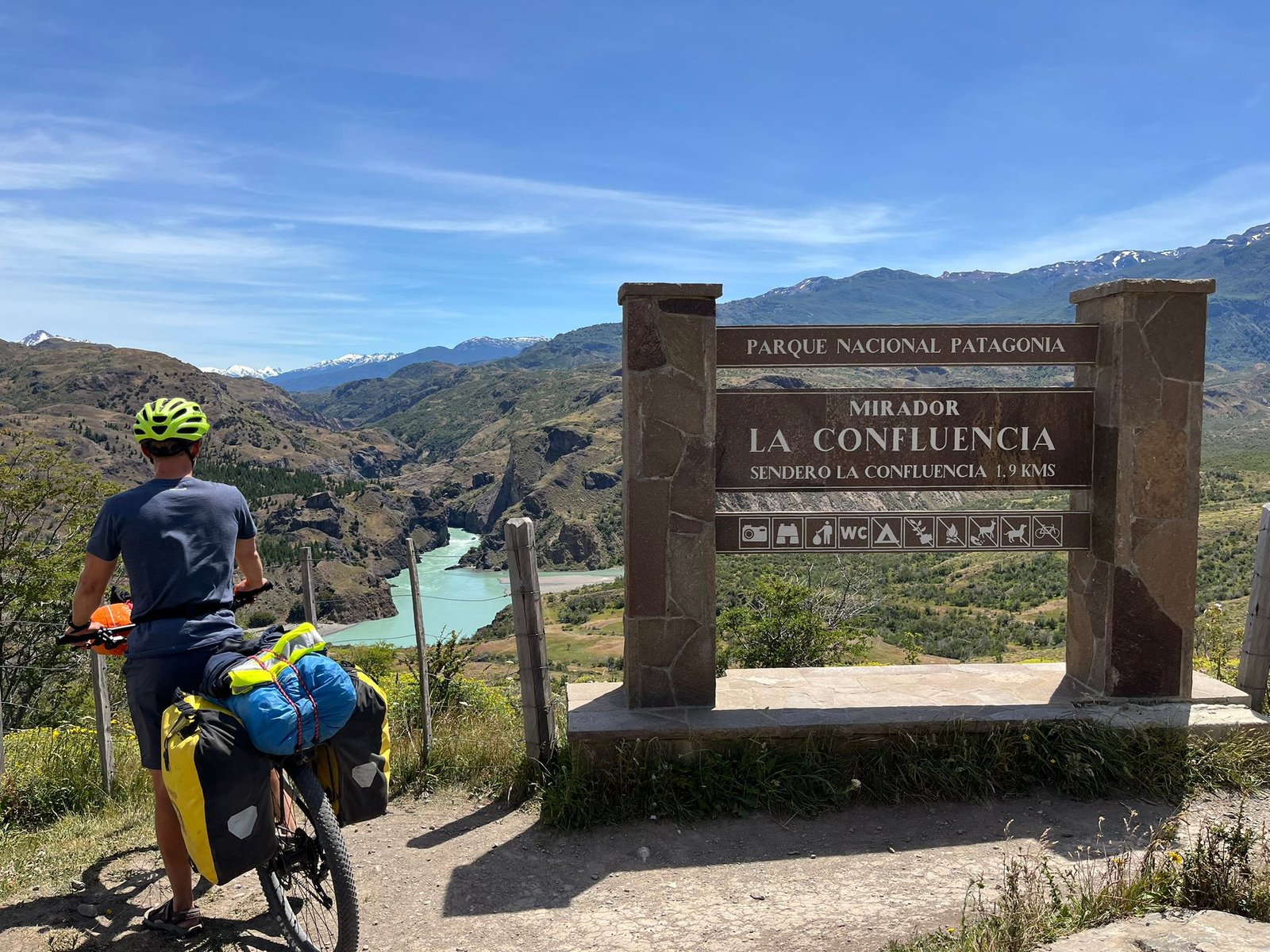
DAY 19: Cochrane to Los Ñadis – 60 km
Today we leave behind the last major town on the route — Cochrane — and ride into the true wilderness of southern Patagonia. The destination: a remote riverside area known as Los Ñadis, about 60 kilometers south, perfect for a night of camping under the stars.
Leaving Cochrane, the road turns to gravel almost immediately. There are no towns, no gas stations, and no cell signal ahead — only forest, rivers, and the open sky. This is where the Carretera Austral begins to feel wild and untamed.
The terrain is rolling, with small climbs and descents, crossing through dense lenga forests and over crystal-clear creeks. The road surface varies — from smooth compact gravel to rough, rocky patches — so take your time and enjoy the solitude.
This part of the route follows the Río Baker for a while, and you’ll be surrounded by massive, untouched landscapes. Waterfalls fall from cliffsides, eagles glide overhead, and the only sounds are wind, water, and your tires crunching gravel.
DAY 20: Los Ñadis to the X-904 junction – 60 km
Today, you ride even further into Patagonia’s wild heart — from your campsite near Los Ñadis, along the southern reaches of the Carretera Austral, until you reach the junction with Ruta X-904, the road that leads to Caleta Tortel. It’s a 60-kilometer ride through silence, solitude, and raw nature.
From the very start, you’re alone with the landscape. The road is 100% gravel, winding through narrow valleys, old-growth forests, and steep river canyons. There are no towns, no stores, no signs — just the occasional wooden bridge, the call of birds, and the distant echo of the wind through the lenga trees.
As you ride south, the terrain becomes increasingly varied. Expect short but steep climbs, sections of rough road, and the occasional muddy stretch — especially after rain. Some descents are rocky and technical, so stay alert and take breaks when needed.
But with the difficulty comes beauty. The region is shaped by glacial erosion, carved into jagged ridges and deep valleys.
DAY 21: Junction with Ruta X-904 to Caleta Tortel – 22 km
Today marks a special transition — from gravel road to wooden walkways, from the forests of Patagonia to the edge of the Pacific fjords. You’re riding the final 22 kilometers of the ruta X-904, all the way to Caleta Tortel, one of the most unique and magical villages in all of Chile.
The road starts as a narrow gravel track, winding through lush forest and following the curves of deep river valleys. There are no shops, no traffic lights — just the sound of your tires on ripio, the rustle of the trees, and the anticipation of the sea.
The terrain is undulating but manageable, with a few short climbs and descents. About halfway through, the road begins to descend toward the coast, revealing dramatic views of the Baker River delta opening into the fjords. The air changes — you’ll smell salt and feel the cool breeze of the ocean.
And then, suddenly, you arrive.
Caleta Tortel appears like a dream — built entirely on wooden walkways, with no cars, no streets, and no concrete. Every building is connected by raised cypress-plank boardwalks that curve and climb through the cliffs and along the water’s edge.
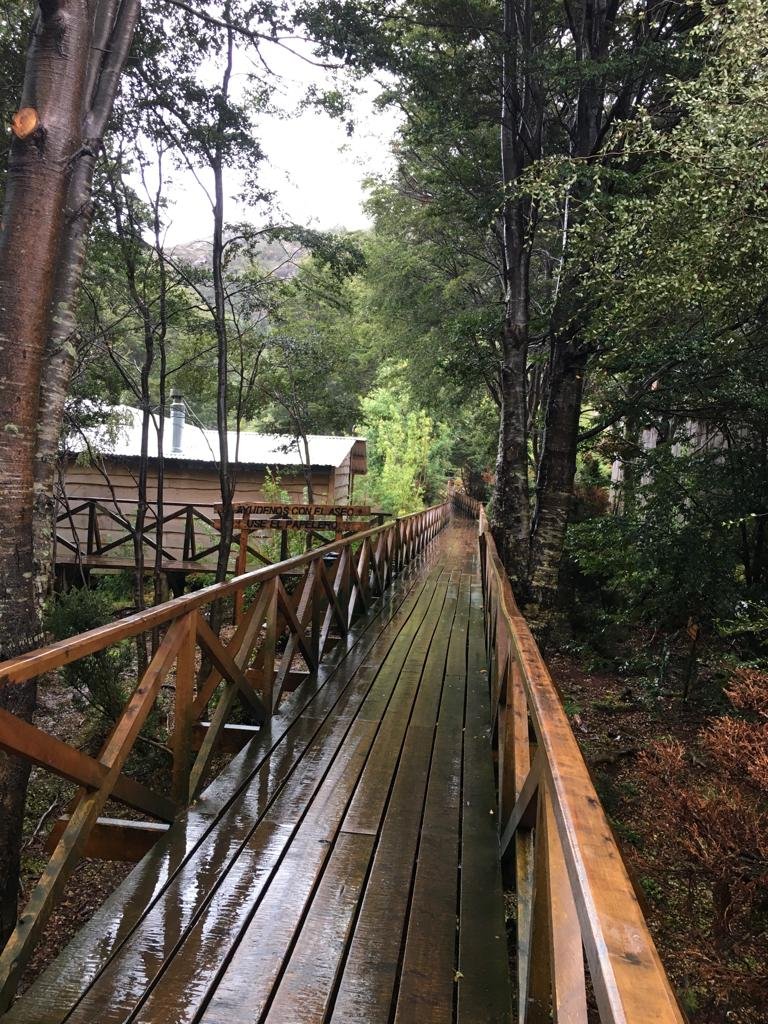
DAY 22: Rest Day in Caleta Tortel – Explore the Wooden Village
After riding over 1,000 kilometers through the wilds of Patagonia, today is for resting — and discovering the magic of Caleta Tortel, one of the most unique and enchanting villages in the world.
No need for pedals today. Instead, you’ll explore a town built entirely on wooden walkways, perched between the mountains and the sea. With no streets, no cars, and no noise but the ocean, Tortel invites you to slow down — and look around.
Here are some ways to make the most of your rest day:
1. Wander the Pasarelas (Walkways):
More than 7 kilometers of cypress-plank boardwalks wind through cliffs, coves, and hilltops, connecting homes, viewpoints, and plazas.
2. Visit the Cemetery and Miradores. The miradores (viewpoints) nearby offer panoramic views of fjords, rivers, and the ocean horizon.
3. Explore the Río Baker Delta:
At the edge of town, the mighty Río Baker meets the Pacific.
4. Take a Boat Tour:
Locals offer boat excursions to places like Isla de los Muertos, glaciers, and nearby fjords. These tours dive deep into Tortel’s rich history.
DAY 23: Caleta Tortel to Ruta 7 – Wild Camp Along the Way
Today marks the start of the final stretch south — and to get there, you’ll need to backtrack from Caleta Tortel to the Ruta 7, riding the same 22 kilometers of ruta X-904 that brought you in. But this time, with heavier legs and a deeper sense of what’s ahead.
Leaving behind the calm of Tortel’s wooden walkways, you’ll pedal back into the forest. The road begins with a climb, as you leave the coast behind and re-enter the world of lenga trees, narrow canyons, and gravel tracks.
The ruta X-904 is unpaved, remote, and wild. It’s only 22 kilometers, but with the full day ahead, you may choose to continue a bit further once you reconnect with Ruta 7, depending on weather, energy, and time. There are no formal accommodations, but there are plenty of places to wild camp
DAY 24: Ruta 7 to 40 km beyond Río Bravo – via Ferry & Ruta X-91
You’ll start from the Carretera Austral, board the ferry at Caleta Yungay, cross to Río Bravo, and continue riding south along the wild and rugged Ruta X-91. It’s a long day with no services, no villages — and likely a night of camping in pure wilderness.
The first leg is a gentle ride along Ruta 7, surrounded by deep forests and glacial rivers, until you arrive at Caleta Yungay. Here, you’ll take a government-operated ferry — free of charge — across a fjord to the southern side at Río Bravo. The crossing takes about 45 minutes and offers incredible views of snow-capped peaks, thick green valleys, and cold ocean water.
Once you arrive at Río Bravo, the terrain changes. You are now on the legendary Ruta X-91, one of the least-traveled and most isolated roads in Chile. It’s a gravel road all the way, with frequent ups and downs, narrow curves, and little to no signs of civilization.
For the next 40 kilometers, you’ll pedal through wild valleys, cross wooden bridges, and pass waterfalls that drop straight from cliffs. The road hugs the contours of the Andes, offering sweeping views and complete silence — broken only by the wind, the water, and the occasional condor overhead.
DAY 25: Final stretch to Villa O’Higgins – The End of the Road
Today, you complete a journey that few people on Earth ever undertake: cycling the entire length of Chile’s southern frontier — all the way to Villa O’Higgins.
From your wild campsite near Ruta X-91, you’ll continue south for the final 50 to 60 kilometers, depending on where you spent the night. The road is gravel, the terrain is remote, and the feeling is unforgettable.
You’ll climb gentle hills, cross hanging wooden bridges, and pedal alongside glacial rivers that twist and turn through narrow valleys. Around every corner, the landscape expands — mountains, icefields, forests, and silence.
There are still no services, but the sense of arrival builds with every kilometer. You’ll pass signs marking your proximity to Villa O’Higgins, and if the sky is clear, you may catch glimpses of the massive Southern Patagonian Ice Field in the distance.
Eventually, the road begins to descend — and there it is:
Villa O’Higgins.
A remote village of just a few hundred people, nestled between mountains and lakes. It’s the southern terminus of the Carretera Austral. There are no roads beyond this point. Only trails, water, and the wild.

DAY 26: Rest Day in Villa O’Higgins
You’ve reached the end of the road — but today, you take the time to truly feel it. Villa O’Higgins isn’t just a village at the end of Chile’s most iconic route — it’s a gateway. A place to pause, reflect, and prepare for whatever comes next.
Today is a rest day, but there’s still one ride worth doing: the final 7 kilometers south of the village, to the official end-of-the-road sign that marks the true conclusion of the Carretera Austral. It’s a short but meaningful journey — take a photo, breathe it in, and remember this moment.
Back in the village, there’s plenty to explore:
– Glacier excursions by boat or on foot, especially the nearby Glaciar Mosco.
– Views of the vast Southern Patagonian Ice Field, if the skies are clear.
– A chance to meet other travelers from around the world — hikers, bikers, and overlanders all converge here.
Today is also when you’ll drop off your bicycle if you rented from Austral Bikes.
If you used Austral Bike’s mochila forwarding service, your backpack will be waiting for you here — sent all the way from Puerto Varas.
DAY 27: Heading Home – or Crossing into Argentina
Today is your final episode — a day of reflection, transition, and decision. After reaching Villa O’Higgins, you now stand at a fork in the journey. For many, it’s time to return home. For others, it’s time to keep going — into the wilds of Argentina.
Option 1: The Journey Home
If you’re heading back to Chile’s central regions or flying abroad, your return starts here. From Villa O’Higgins, you’ll need to take a bus to Cochrane, a long but scenic ride through the same breathtaking landscapes you’ve cycled. From Cochrane, transfer to another bus that will take you to the airport in Balmaceda, near Coyhaique.
The entire return trip may take two to three days, depending on connections, weather, and availability — so it’s important to plan ahead and book in advance when possible. Many travelers choose to break up the trip with a night in Cochrane or Coyhaique before flying out.
Option 2: Cross into Argentina
For the bold and adventurous, there’s another path — one that continues south. From Villa O’Higgins, you can cross into Argentina via a multi-stage journey involving boat rides, hiking, and border formalities.
You’ll start by arranging a boat across Lago O’Higgins to Candelario Mancilla. From there, it’s a 22-kilometer hike or bike-push through remote forest trails to reach Lago del Desierto, and then another boat to reach the road to El Chaltén and El Calafate.
This crossing is only recommended for experienced travelers with lightweight gear, proper planning, and a spirit for the unexpected. Weather, boat schedules, and trail conditions can all impact the experience — but it’s one of the most unique and remote border crossings in the world.
